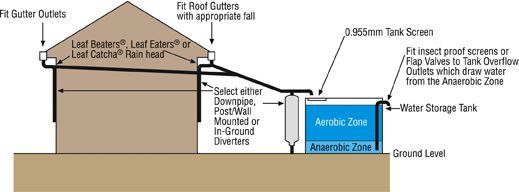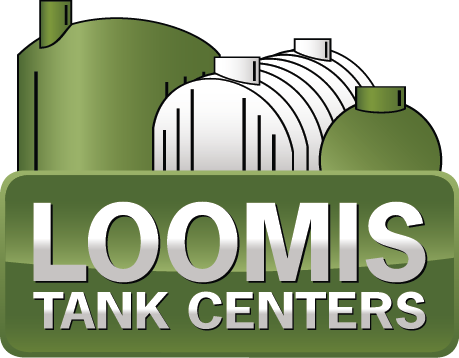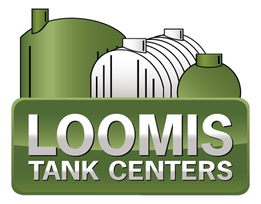What You Need To Create a Rain Water Harvesting System
8 Essential Components
Rainwater harvesting, because of its many benefits has become very popular in recent years. If done properly, rainwater catchment can be used for irrigation, bathing, washing vehicles and a myriad of other uses. Rainwater collection is cost efficient in any area that gets moderate to high rainfall or that has consistent rainfall throughout the year. Ideal candidates are people who have large roof square footage as well as people who have average to high volume irrigation needs.
The most common rain collection and distribution system used is the roof water runoff catchment type. Here are the 8 components needed for this basic rain harvesting system.

1 - Roof Gutters
These are critical as they are the means of conveyance that directs the rainwater from the roof to the water tank or cistern, much like the way many rivers ultimately feed a large body of water. The ideal size for a gutter is 5 inches wide. Galvanized steel or aluminum gutters are preferred because they are more durable than other types. Ideally they should be fitted with a mesh screen to prevent leaves and debris from clogging the gutter system, as well as to make them easier to clean.
2 - Gutter Downspouts
Space downspouts a minimum of 20 feet apart and a maximum of 50 feet apart. Provide 1 square inch of downspout area for every 100 square feet of roof area. Downspouts come in many configurations: square, round and corrugated round are the most popular.
3 - Downspout Leaf Filters
These filters fit underneath the downspout. They come equipped with a screen on the front of the unit that prevents leaves and other debris from entering the rain harvesting collection system. At the bottom of the leaf filter a finer mesh screen is provided to prevent mosquitoes from entering the rainwater collection system.
4 - First Flush Water Diverters (also referred to as Roof Washers)
These rainwater diverters are designed to redirect the initial contaminated rainwater that contains debris, dust and bird droppings away from the clean water storage tank into a separate storage pipe. This helps to ensure that the sediment from the contaminated rainwater doesn’t enter the main water storage tank and plug up the water distribution system. These first flush diverters should be set up to hold at least 10 gallons of dirty rainwater for every 1000 sq. feet of roof collection area. They are available in above ground or below ground models that can be installed at every downspout, or larger diverters can be installed that handle multiple downspouts. The contaminated rainwater can be used to irrigate selective plant types, including most non-edible vegetation.
5 - Water Storage Tanks
You can't store water without a storage tank! These are available in above and below ground tanks and are made from polyethylene plastic, fiberglass, steel, wood or concrete. They should be opaque (not see-through) to prevent algae growth. These water tanks should come equipped with an inlet and outlet fitting as well as an overflow fitting and pipe to divert the excess rainwater away from the water tank when it becomes full. Water tanks come in a variety of sizes. To determine the size that best fits your needs, consider annual rainfall totals for your area along with the roof square footage available for rain collection. 1 inch of rain on a 1000 square foot roof surface provides 623 gallons of water. You must also take into account your water usage requirements when sizing the tank. FIND THEM HERE
6 - Distribution System
This is the system that directs the rainwater from the water storage tank to the landscape area. This can be a hose, constructed channels, pipes or a drip irrigation system. Valves and diverters can be used to control the flow amount and direction. If gravity is not an option, an in-line electric or solar pump can be used for distribution. These water pumps should come equipped with a switch that turns it off in the event that the water tank becomes empty. A filter after the pump should be installed to help reduce sediment that can clog the system.
7 - Water Level Indicator
This device shows how much rainwater is available for use in the storage tank. They come in several styles. The most popular are the steel target assembly or plastic tube and ball.
8 - Insect Screens and Flap Valves
These should be installed at the ends of all pipes, inlets, outlets and overflows. This keeps out pests and mosquitoes and ensures that the rainwater harvesting system is vented properly.
For More Information
For more information about these systems, contact a rainwater harvesting system expert near you. Loomis Tank is always happy to answer questions. Contact a representative today for a free consultation: 1-800 549-5514.
Request a Quote for a Rainwater Harvesting System
Waste Not - Want Not
CUT WATER COSTS, PROTECT THE ENVIRONMENT AND ENHANCE YOUR LANDSCAPE OR GARDEN
Loomis Rainwater Collection (download brochure)


